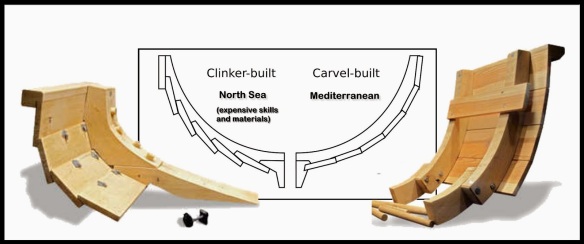
A comparison of clinker-building and carvel-building styles.
The origin of lap-strake ships
The ships of the Vikings were built shell first on a backbone consisting of keel, stem and stern. The primary component was a shell of planks, fastened together with clench nails through their overlapping edges, hence the building technique is called ‘lap-strake’. Finds of such vessels at the Nydam bog deposit in southern Jutland indicate that this way of building vessels was replacing sewn plank boats in Scandinavia and northern Germany in the first centuries AD. At the same time oars replaced paddles as means of propulsion. It might be that these changes reflect influences from the Roman navy, which was operating on the Rhine and in the southern North Sea then.
The lap-strake technique produces a hull which is strong and flexible. Caulking material inlaid between the overlapping planks during the construction made the hull watertight. Various materials were used, but the most common in Viking ships were loosely spun yarns of wool. To stiffen the hull, frames were inserted. In the Nydam vessels they consisted of a naturally curved timber – a compass timber – that was lashed to cleats carved out of the planks and of a thwart, also lashed. As the thwarts served as seats for the rowers, they – and thus the frames – sat roughly 1 m apart. This principle for spacing the framing remained in use until the end of the Viking Age. Rowlocks, mounted on the gunwale, served the oars, and the vessels could thus not be built higher than rowing allowed. Boats could be of a notable size; the best preserved of the Nydam boats, dated to c. ad 320, had twenty-eight oars and measured c. 23.5 m in length and 3.5 m in beam (Bill et al. 1997: 44).
During the fifth to eighth centuries, important improvements took place. Finds from the Anglo-Saxon ship grave Sutton Hoo in England and from Gredstedbro in southwestern Denmark, show that in the seventh to eighth centuries lashing of frames was replaced with tree-nailed fastenings in the southern North Sea area. The Storhaug find from Avaldsnes in Norway shows a large rowing ship with a solid plank with oar holes instead of rowlocks. The grave, dated to between ad 680 and 750, is also the first find in Scandinavia of a ship where the compass timber in the frame does not reach from gunwale to gunwale (Christensen 1998).
The introduction of sail
Despite the widespread use of sail in Gaul and Britain in Roman times, there is little evidence that Scandinavians adopted this technology before the Viking Age. We find the earliest confirmation in the Baltic, where Gotlandic picture stones from the eighth century change from showing rowing vessels to showing ships with sails (Imer 2004). From around ad 800 depictions of sailing ships appear on Viking coins, runic stones and graffiti, but the Oseberg ship from ad 820 is the oldest find of a sailing vessel in Scandinavia. Some written evidence points to the continuous use of sail in the southern North Sea and the Channel from Roman times on. That it seemingly was not adopted in Scandinavia is puzzling, but may reflect the unwillingness of shipowners rather than any technological restraint in shipbuilding.